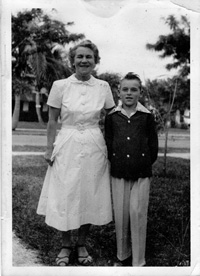Grandma’s Apron
By Joyce Badgley Hunsaker
This ol’ flimsy apron
Is faded now, and worn,
But it was cannin’ peaches with my Grandma
On the day that I was born.Its body’s made from flour sacks,
And its trim is made from sheets
She dyed when they got tattered
With the juice from garden beets.I recall when I was little,
It would shoo the hens away
After feedin’ ‘em from its billows
In the side yard, every day.It brought biscuits from the cookstove
And wrapped around the bail
Of many a milkin’ bucket
And many a settlin’ pail.It cooled my brow of fever,
It dried my face of tears,
It swatted my disgraced behind
When I was naughty through the years.Sometimes I got to wear it
Bakin’ cookies, stews or breads.
“The apron is a prime ingredient
Of womanhood,” Grandma said.But lest you think it left off
In a “woman’s place,” I tell
How it cradled a dead-eye pistol
Shootin’ rattlers by the well.It reroofed sheds and feed stalls
As the men took jobs in town;
Stacked hay, chopped wood, set fence posts
When no farmhand was around.It bottled little bummer lambs
And pulled a calf or two.
It even shoed the horses.
There wasn’t much it didn’t do.It took a heap o’ livin’
To finally wear it out,
Till the rips, the mends, and patches
Were what it was all about.Kind of like life itself, you see.
This apron said, “I survived
Though time may change and rearrange,
My spirit is still alive.”Now when Grandma died, the relatives
Took her treasures large and small.
And me – I got her apron,
The most cherished thing of all.
Source
Good Old Days Magazine, September/October 2010
Posting of Grandma's Apron by Joyce Hunsaker is dedicated to Hildur, a Swedish Grandmother who lived in the servant's quarters of the Dallas Estate off of Mount Holly road, Katonah, NY.
She was an immigrant in steerage from the 1920s with her three sons , two lost while still young, one to a salmonella poising at a middle school and the other to polio. Later the third went missing off of Okinawa in WWII, found and returned to America in 1945. He is buried at Arlington National Cemetery. She, with her husband, Ernest, are buried in Lake Worth, Florida.
Her apron included ground coffee stains, flour from a daily sampling of Swedish pancakes along with dough from handmade paper-thin ginger cookies, all mixed in with dark-blue stains from garden-picked black berries.
